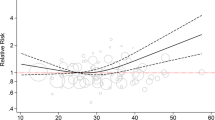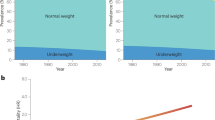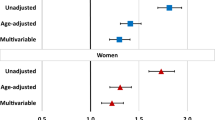Abstract
Obesity is an excessive accumulation of fat that can impair health. Because the direct measurement of body fat is difficult to perform, a number of anthropometric measures have been employed as surrogates, of which BMI is the most commonly used. However, its usefulness has been questioned as a BMI in the overweight and mildly obese range is associated with improved survival and fewer cardiovascular events than a BMI in the normal range, a phenomenon known as the 'obesity paradox'. Waist circumference, waist-to-hip ratio, and waist-to-height ratio take into consideration body-fat distribution, especially abdominal obesity, and seem to predict cardiovascular risk better than does BMI.
This is a preview of subscription content, access via your institution
Access options
Subscribe to this journal
Receive 12 print issues and online access
$209.00 per year
only $17.42 per issue
Buy this article
- Purchase on Springer Link
- Instant access to full article PDF
Prices may be subject to local taxes which are calculated during checkout




Similar content being viewed by others
References
Centers for Disease Control and Prevention. State-specific obesity prevalence among adults—United States, 2009 [online] http://www.cdc.gov/mmwHr/preview/mmwrhtml/mm59e0803a1.htm?s_cid=mm59e0803a1_e%0D%0A, (2010).
WHO. World Health Report (WHO, Geneva, 2006).
National Institute of Diabetes and Digestive and Kidney Diseases. Understanding adult obesity [online], (2008).
WHO. Obesity and overweight [online] http://www.who.int/mediacentre/factsheets/fs311/en/index.html, (2006).
AACE/ACE Obesity Task Force. AACE/ACE position statement on the prevention, diagnosis and treatment of obesity (1998 revision). Endocr. Pract. 4, 297–350 (1998).
National Heart, Lung and Blood Institute. Overweight and obesity [online] http://www.nhlbi.nih.gov/health/dci/Diseases/obe/obe_whatare.html, (2010).
Gallagher, D. et al. Healthy percentage body fat ranges: an approach for developing guidelines based on body mass index. Am. J. Clin. Nutr. 72, 694–701 (2000).
Romero-Corral, A. et al. Normal weight obesity: a risk factor for cardiometabolic dysregulation and cardiovascular mortality. Eur. Heart J. 31, 737–746 (2010).
Poirier, P. et al. Obesity and cardiovascular disease: pathophysiology, evaluation, and effect of weight loss: an update of the 1997 American Heart Association Scientific Statement on Obesity and Heart Disease from the Obesity Committee of the Council on Nutrition, Physical Activity, and Metabolism. Circulation 113, 898–918 (2006).
Romero-Corral, A. et al. Association of bodyweight with total mortality and with cardiovascular events in coronary artery disease: a systematic review of cohort studies. Lancet 368, 666–678 (2006).
Allison, D. B., Zhu, S. K., Plankey, M., Faith, M. S. & Heo, M. Differential associations of body mass index and adiposity with all-cause mortality among men in the first and second National Health and Nutrition Examination Surveys (NHANES I and NHANES II) follow-up studies. Int. J. Obes. Relat. Metab. Disord. 26, 410–416 (2002).
Flegal, K. M., Graubard, B. I., Williamson, D. F. & Gail, M. H. Cause-specific excess deaths associated with underweight, overweight, and obesity. JAMA 298, 2028–2037 (2007).
McGee, D. L. et al. for the Diverse Populations Collaboration. Body mass index and mortality: a meta-analysis based on person-level data from twenty-six observational studies. Ann. Epidemiol. 15, 87–97 (2005).
Adams, K. F. et al. Overweight, obesity, and mortality in a large prospective cohort of persons 50 to 71 years old. N. Engl. J. Med. 355, 763–778 (2006).
Whitlock, G. et al. Body-mass index and cause-specific mortality in 900,000 adults: collaborative analyses of 57 prospective studies. Lancet 373, 1083–1096 (2009).
Lewis, C. E. et al. Mortality, health outcomes, and body mass index in the overweight range: a science advisory from the American Heart Association. Circulation 119, 3263–3271 (2009).
Romero-Corral, A. et al. Accuracy of body mass index in diagnosing obesity in the adult general population. Int. J. Obes. (Lond.) 32, 959–966 (2008).
Pouliot, M. C. et al. Waist circumference and abdominal sagittal diameter: best simple anthropometric indexes of abdominal visceral adipose tissue accumulation and related cardiovascular risk in men and women. Am. J. Cardiol. 73, 460–468 (1994).
Després, J. P. & Lemieux, I. Abdominal obesity and metabolic syndrome. Nature 444, 881–887 (2006).
Després, J. P. et al. Abdominal obesity and the metabolic syndrome: contribution to global cardiometabolic risk. Arterioscler. Thromb. Vasc. Biol. 28, 1039–1049 (2008).
Lee, C. M., Huxley, R., Wildman, R. P. & Woodward, M. Indices of abdominal obesity are better discriminators of cardiovascular risk factors than BMI: a meta-analysis. J. Clin. Epidemiol. 61, 646–653 (2008).
Balkau, B. et al. International Day for the Evaluation of Abdominal Obesity (IDEA): a study of waist circumference, cardiovascular disease, and diabetes mellitus in 168,000 primary care patients in 63 countries. Circulation 116, 1942–1951 (2007).
Janssen, I., Katzmarzyk, P. T. & Ross, R. Waist circumference and not body mass index explains obesity-related health risk. Am. J. Clin. Nutr. 79, 379–384 (2004).
Arsenault, B. J. et al. The hypertriglyceridemic-waist phenotype and the risk of coronary artery disease: results from the EPIC-Norfolk prospective population study. CMAJ 182, 1427–1432 (2010).
Yusuf, S. et al. Obesity and the risk of myocardial infarction in 27,000 participants from 52 countries: a case-control study. Lancet 366, 1640–1649 (2005).
de Koning, L., Merchant, A. T., Pogue, J. & Anand, S. S. Waist circumference and waist-to-hip ratio as predictors of cardiovascular events: meta-regression analysis of prospective studies. Eur. Heart J. 28, 850–856 (2007).
Zeller, M. et al. Relation between body mass index, waist circumference, and death after acute myocardial infarction. Circulation 118, 482–490 (2008).
Hsieh, S. D., Yoshinaga, H. & Muto, T. Waist-to-height ratio, a simple and practical index for assessing central fat distribution and metabolic risk in Japanese men and women. Int. J. Obes. Relat. Metab. Disord. 27, 610–616 (2003).
Romero-Corral, A. et al. The waist index is better associated with history of myocardial infarction than body mass index, waist circumference and waist-to-hip ratio [abstract]. Circulation 118 (Suppl.), a3222 (2008).
Heitmann, B. L., Erikson, H., Ellsinger, B. M., Mikkelsen, K. L. & Larsson, B. Mortality associated with body fat, fat-free mass and body mass index among 60-year-old Swedish men—a 22-year follow-up. The study of men born in 1913. Int. J. Obes. Relat. Metab. Disord. 24, 33–37 (2000).
Bigaard, J. et al. Body fat and fat-free mass and all-cause mortality. Obes. Res. 12, 1042–1049 (2004).
De Lorenzo, A., Martinoli, R., Vaia, F. & Di Renzo, L. Normal weight obese (NWO) women: an evaluation of a candidate new syndrome. Nutr. Metab. Cardiovasc. Dis. 16, 513–523 (2006).
Flegal, K. M. & Graubard, B. I. Estimates of excess deaths associated with body mass index and other anthropometric variables. Am. J. Clin. Nutr. 89, 1213–1219 (2009).
Fuller, N. J., Sawyer, M. B., Laskey, M. A., Paxton, P. & Elia, M. Prediction of body composition in elderly men over 75 years of age. Ann. Hum. Biol. 23, 127–147 (1996).
Lee, S. Y. & Gallagher, D. Assessment methods in human body composition. Curr. Opin. Clin. Nutr. Metab. Care 11, 566–572 (2008).
Author information
Authors and Affiliations
Contributions
B. Cepeda-Valery and A. Romero-Corral contributed to discussion of content for the article and researched data to include in the manuscript. All the authors reviewed and edited the manuscript before submission, and revised the manuscript in response to the peer-reviewers' comments.
Corresponding author
Ethics declarations
Competing interests
The authors declare no competing financial interests.
Rights and permissions
About this article
Cite this article
Cepeda-Valery, B., Pressman, G., Figueredo, V. et al. Impact of obesity on total and cardiovascular mortality—fat or fiction?. Nat Rev Cardiol 8, 233–237 (2011). https://doi.org/10.1038/nrcardio.2010.209
Published:
Issue Date:
DOI: https://doi.org/10.1038/nrcardio.2010.209
This article is cited by
-
Association between obesity and mortality in the Costa Rican elderly: a cohort study
BMC Public Health (2022)
-
Incidence, characteristics and clinical relevance of acute stroke in old patients hospitalized with COVID-19
BMC Geriatrics (2021)
-
Risk of coronary heart disease among cancer survivors with different prediagnosis body mass index
Scientific Reports (2021)
-
Obesity paradox in group 1 pulmonary hypertension: analysis of the NIH-Pulmonary Hypertension registry
International Journal of Obesity (2017)
-
Coronary Heart Disease Risk Factors and Outcomes in the Twenty-First Century: Findings from the REasons for Geographic and Racial Differences in Stroke (REGARDS) Study
Current Hypertension Reports (2015)



